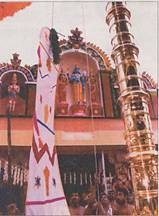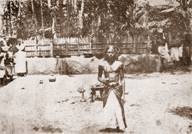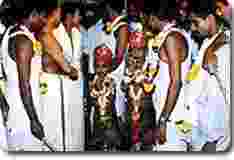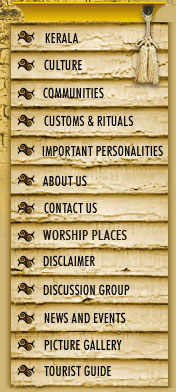|
Kadusarkarayogam
Kadusarkarayogam is
a rare mixture of natural materials, which is used to make or fix
idols in temples. This is considered to be an auspicious and
noble yogam. Silver and gold wires are used for making bones and veins of the idol. Thereafter the idol will be covered by using Kadusarkara, a mixture made of Kavi (saffron) soil, Kadukka, Thannikka, Nellikka, kozhipparal and chenchalyam. The idol at Sree Padmanabha Swami Temple of Thiruvananthapuram is made by using Kadusarkarayogam.
Kakkapula
Annual ancestral worship performed by Paraya community is called Kakkapula.
Kalakabhishekam
Kalakabhishekam is done using Kalabham to cover the idol fully. Kalabham is made of sandal, akil, gulgulu, manchi, kumkum flower,
kottam,iruveli and ramacham. It is very special to Lord Siva and
Lord Vishnu
Kalamezhuthu
Kalamezhuthu is a function organised in temples and houses as offerings. It
is performed for prosperity, recovery from illness and as a religious
function. The practice is to draw the figure of a goddess by using
several natural powders and conduct of pooja and songs. The
drawing of ‘Bhadrakali’ (Durga) is commonly used. The drawing of
hunters and snakes are also practiced to conduct kalamezhuth pattu (songs) in the same manner
Karkidaka Vavu
The new moon day in the month of Karkidakom (July-August) is the Karkidaka Vavu. This is famous for bali (paying homage) to the departed soul of ancestors. It is believed that the departed souls will attain Moksha (salvation) if bali is performed on this day. Karkidaka Vavu is the first Amavasi of Dakshinayanam. The first Amavasi of Utharayanam comes in the month of Makaram (January-February). The first is related to fathers and latter to Gods. Therefore, Karkidaka Vavu became famous for performing bali to ancestors. Thousands of people will throng on the riverbanks and beaches to offer holy prayers and bali for the departed souls of their fathers. In north Kerala, it
is believed that the dead souls will visit the homes on the day of Karkidaka Vavu. The relatives will prepare Ada (sweet rice cake) and wait for the arrival of the soul.
Kalasam (Reviving Divinity)
Kalasam is a ritual performed in temples to revive the divinity of the idol
after the consecration ceremony. The holy water is poured over the
idol. Kalasam is also done when the power of the worshipping deity is found weak. There are several types of Kalasams. Ottakalasam (one kalasam), Irupthanchukalasam (twenty five kalasams), Nootyettu Kalasams (one hundred and eight kalasams), Sahasrakalasam (one thousand kalasams) etc. This depends upon the number of pots (Kumbhams) used for conducting the pooja.
Kamadevapooja
A festival of women in North Kerala connected with pooram celebrations during the month of Meenom (March-April) (Also see Meenapooram).
Kandakassani (Misery period)
Astrologically, Kandakassani is the period of travel of Shani (Saturn) in the Chandralegna or its 4th, 7th or 10th Bhavas.
This is termed as a most miserable period. Grief, illness,
exile from native region, poverty, and defamation are the
results. It is believed that Kandakasshani may take away the life ultimately.
Kani (first sight of day)
The
person or thing, which one sees immediately after awakening from
sleep in the early morning, is known as ‘kani’. It is believed
that the result of the day will depend upon this view. The ‘Vishu’
celebrations start with ‘kani’, which will be arranged in each home to
be seen by all members of the family in the early morning.
Kanneru (Black eye)
There isa belief that adverse effects will happen if some people look
and make comments on any agriculture crop or new buildings under
construction or any other beautiful objects or beings. This is known as Kanneru or as ‘drishtipadam’, ‘drishtibadha’,’karimkannu’, and
‘nokkudosham’. In order to save them from the ‘Karimkannanmar’
(black-eyed persons), vulgar models were exhibited in the crop fields,
in front of new constructions etc.
Kannok
When relatives go to the house where death occurred, they used to take betel vine, tobacco, avil (beaten rice), sharkara (jaggery), and banana. This is known as Kannok.
Karkidaka Samkranthi
The last day of month of Midhunam (June-July) is celebrated as Karkidaka Samkranthi.
Karnavedham
Karnavedham is one of the Shodashacharangal of Namboothiris. Karnavedham is the ceremony of ear-boring or otherwise known as Kathukuthal. Karnavedham is done for both boys and girls on an auspicious day.
Kathukuthal (ear-boring)
Kathukuthal (Karnavedham) is the ear-boring ceremony, which takes place during the first year of birth. The Kathukuthu of
children was celebrated as a great festival in olden days. This
custom is practiced in different forms by different castes.
Generally this function is arranged when the children attain the age
of four or five. A gold or copper wire or thorn of lime tree is to
pierce the bottom middle portion of the ear usuallyby a Thattan (goldsmith).
Kattichatham
Annual ancestral worship performed by Pulaya community is called Kattichatham.
Kesantham
Kesantham is one of the Shodashacharangal of Namboothiris. Kesantham is a rite to remove the tuft from the head of a boy.
Kettukalyanam
Kettukalyanam was a custom prevalent among the matrilineal family during ancient
times. This was a function of tying thali to the girls by an
elderly person. He had no other relation with the girl. It is also
known as Thalikalyanam. The thalikettu was arranged before the girl attained puberty. The age of 7, 9 or 11 were considered best for thalikettu. If thalikettu was not done before the girl attained puberty, it was considered as a disgrace to the family. Kettukalyanam was arranged by erecting huge pandals in front of the house and by serving feast according to the status
and financial position of the family. The function will last
for four days. Auspicious day will be fixed for thalikettu.
Relatives will be invited for the function. At the fixed time,
the girl in new dresses will be brought to the decorated pandal and thalikettu will be done in front of Nirapara and Nilavilakku. Kettukalyanam and marriage are different. The real marriage functions of Nairs’ were very simple. This was known as Pudavakoda.
The bridegroom reaches the house of the bride in the fixed hour along
with his close relatives and gives pudava (cloth) to the bride in
front of Nirapara and Nilavilakku. The customs of thalikettu,
exchange of rings exchanging floral garlands etc. that prevalent now
were not practiced in olden days. Kettukalyanam gradually came to an end with the abolition of matrilineal system.
Kettunira
Kettunira or Kettumurukku is one of the procedures of Sabarimala pilgrims. This was performed before leaving for Sabarimala on pilgrimage.
Kidakkakalyanam
Kidakkakalyanam is a system of marriage resembling Pudamuri. This was in practice at Palakkd and Chittoor. Instead of giving cloth to the bride as in Pudamuri, here money is given. All other functions are same as that of Pudamuri. (Also see Pudamuri).
Kodi Archana
The pooja performed in temples for worshipping God. The Sahasranamam (thousand verse) will be repeated one thousand times through this pooja.
Kodiyettam (Flag hoisting)

Kodiyettam is the beginning of temple festival. In temple where there is no
permanent flag post areca nut or other available trees will be cut and
brought in a festive procession and fixed in appropriate place.
The temple flag is hoisted in
such posts marking the beginning of the festival No other programmes will be held on that
day. Festival starts from the next day onwards.
Komaramthullal

The oracle dance performed in temples, especially Devi temples during festivals to inform the presence of Devi is known as Komaramthullal.
It is also known as Velichappad thullal. There will be
identified persons in each temple to perform this act. They tie bells
around their waist, takes out sword in hand, wear chilambu in legs and dance with divine sword in hand and announce the desire of the presiding deity.
Koottam (Public Forum)
Kootam was a public forum organised to discuss and solve public issues. There were many forms of Kootams like Sabha, Tharakootam, Deshakootam, Nattukootam etc. People obeyed the decisions taken in such Kootams.
Koppukodukkal
The
grocery and vegetables given by the husband to wife’s house in the
matrilineal system during Onam and Thiruvathira is known as Koppukodukkal. The status of the matrilineal society is assessed depending upon the quantity of Koppukodukkal.
Kshethracharangal
The procedures, customs and practices to be observed in temples are known as Kshethracharangal.
Kshethrakalakal (art forms of temple)
The art forms performed in temples are known as Kshethrakalakal. Koothu, Koodiyattom, Patakam, Ashtapadi, Krishnanattam, Kadhakali, Thullal, Mohiniyattom are main among them. Local festivals like Padayani, Kettukazcha, Kuthiyottam are some others.
Kuruthy
Kuruthy is an offering performed in Bhagavathy temples. It is otherwise known as Guruthi or Gurusi.
In olden days animals or birds such as goat or fowl were sacrificed
as part of the ritual. It is not in vogue now. Instead, a
mixture of turmeric and quicklime will be added in water, as it will
have the colour of blood. This mixture is used for performing Kuruthy. Tuesday and Friday are good for performing the ritual. Kuruthy is also performed in connection with Theyyam, Thira and Pana.
Kuthyottam

Kuthyottam is an offering made in the Devi Temples of South Kerala. At
Chettikulangara and Attukal Devi temples this was performed
with temple festival. |



